Fostering creativity in the SLAB
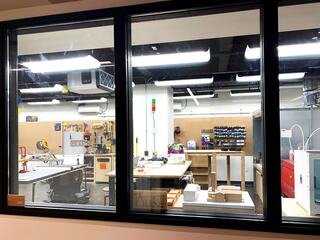
SERA project teams have an array of tools to assist with their design and presentation work, and they love nothing more than to dive in and playfully experiment as they bring their visions to life. A few months ago, we learned how SERA’s Viz Team uses augmented and virtual reality to not only present projects to clients, but also to assist with the design process.
Today’s post features SERA’s SLAB (Sera LABoratory), an on-site workshop where design teams can use tools like laser cutters and 3D printers to create physical models of their designs.
SLAB manager Nick Lavelle has a passion for creating physical objects, and he encourages others to use the SLAB, which is “… an integral part of our design culture, a place for physical experimentation and exploration.”
The SLAB has supported a wide array of SERA projects, resulting in some pretty innovative and beautiful artistic creations.
Telling the story of the Eugene Riverfront District
Senior Urban Planner, Martin Glastra van Loon came to Nick with an idea to create a physical model of the Eugene Riverfront District Master Plan to help visualize the intent of the design. Conveying the vision of such a large-scale project isn’t easy, and the team made use of every tool at their disposal to tell the story, including AR/VR and a physical model.
The challenge of this model was to highlight the spaces between the buildings, rather than the buildings themselves, which is a key element of a district plan.
“When it comes to comprehending a master plan project, the challenge is flipping our brains between thinking about the buildings themselves to considering the spaces between them. There’s nothing like a model to express the qualities of the spaces between. When we do this, we consider not just the client who is developing the building, but also the responsibility we have to an unrepresented client – the collective community.” Martin Glastra van Loon
The reflective, earthy quality of copper provided the inspiration for the project, as it was both beautiful and flexible enough to draw attention to the spaces between the buildings, without being overshadowed by the structures.
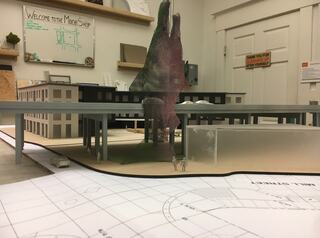
The Eugene Riverfront District's working model.
The process included experimentation with treatments that created a variety of different colored patinas on the copper, including blue for the river and red to mark the new connections to the city. The results were inconsistent, but the effort highlights a guiding philosophy of the SLAB, which is to try new things, create, and explore. Ultimately, the design used pristine copper to bring attention to a new bridge, the 5th Street extension to the Willamette River, and the connections the new plan would create for downtown Eugene.
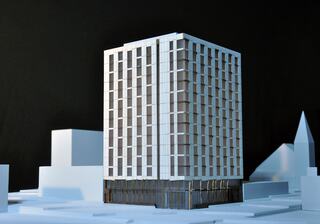
The end result was presented to the client in a wooden box that featured copper details, along with the project slogan “where the city meets the river.” In the end, it was a great example of how the experience of a model can be like theater — with drama, suspense, and enticement to open the box and experience the big reveal.
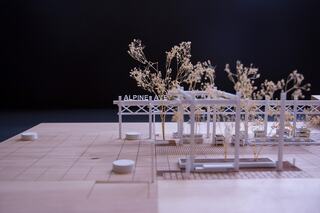
Alpine Avenue: Visualizing the remarkable details
The Alpine Avenue Streetscape Plan is another project that benefitted from a variety of physical modeling approaches in the SLAB, from showcasing the impact of the design’s large metal structures to testing the functionality of custom-designed furniture.
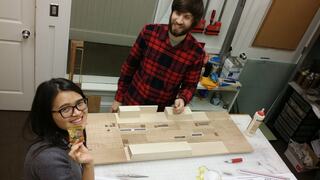
Building the Alpine Avenue model.
The design for the Alpine Avenue model was playful, with pieces that could be added and removed as the team collaboratively visioned the design. By focusing on the details and getting creative with laser techniques, the wood was etched to represent strikingly different ground treatments.
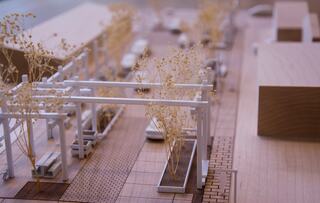
But more than just being fun, the model explained the spatial complexity and gateway element that the large metal structures gave to the design.
“It was meant to be a pretty basic model, but there’s attention to detail – the pavers, concrete patterns, furnishings, and structures stood out. You look at it, and you understand it. And the design felt like it was meant to be.” Nick Lavelle
The SLAB was also used to test the design of the custom modular picnic tables. The design team wanted to understand how people would interact with and sit at the tables, so, like kids with a refrigerator box, they built a model with cardboard and duct tape.
Ultimately, this experimental, hands-on approach is what the SLAB is all about, and it’s why many of our designers enjoy watching their projects come to life as they create with physical materials. Nick and other SLAB enthusiasts want others at SERA to realize that though they can work out problems through visual media – sketching, working in Revit, getting their hands on something, feeling it, and experiencing it physically can completely change their understanding. This Alpine Avenue display in our old office told the story of the project so others could not only understand it but also visualize how SLAB can help bring their own visions to reality.
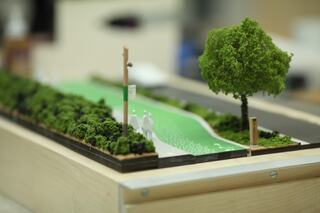
The ingenuity supported by the SLAB is just one of the remarkable ways creativity is prioritized and valued at SERA. SLAB is a resource that encourages people at the firm to go beyond the bounds of their imaginations, explore creative solutions, and then put them to the test.

Three examples of the incredible diversity of things SLAB produces: a custom book cover for our partners at the Center for Tribal Nations, a facade model for the Hyatt Centric, and a model of the geography of Marble Canyon.

